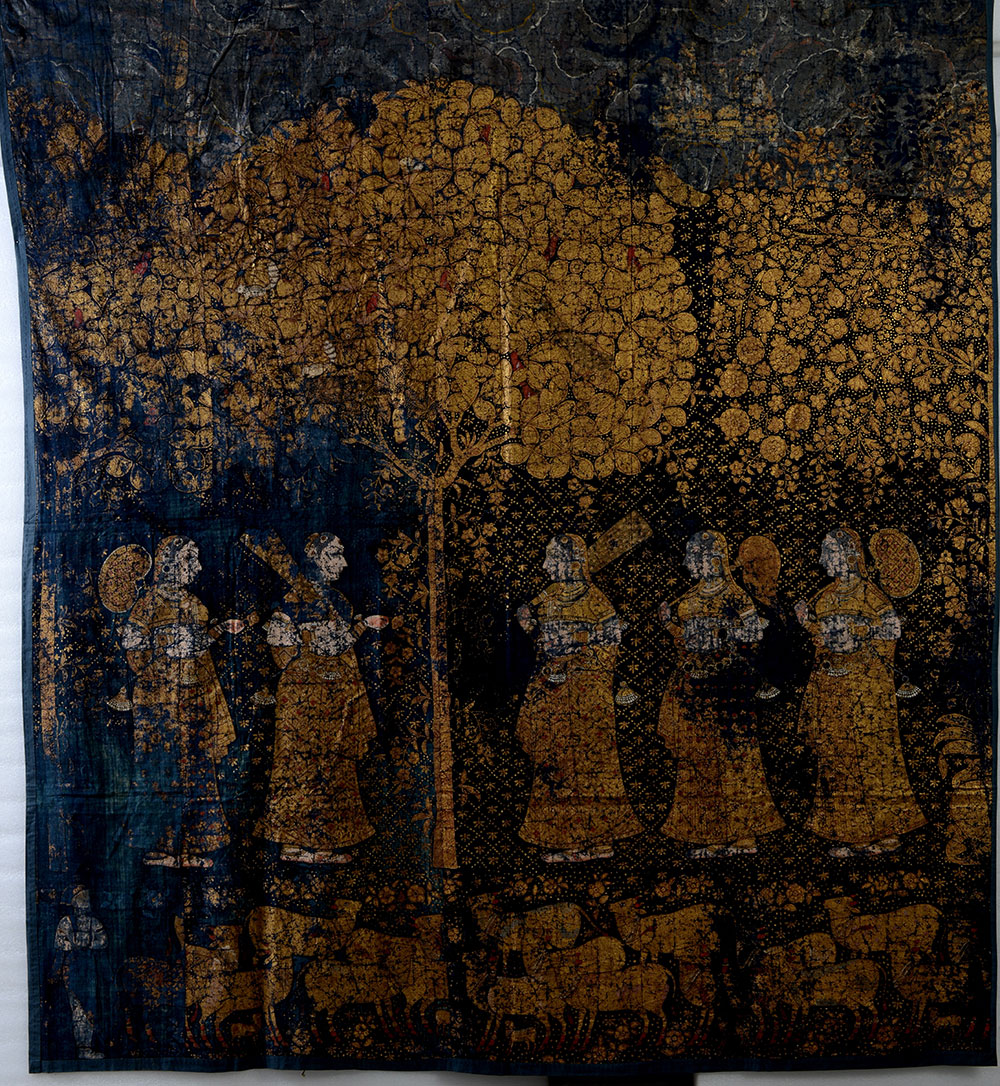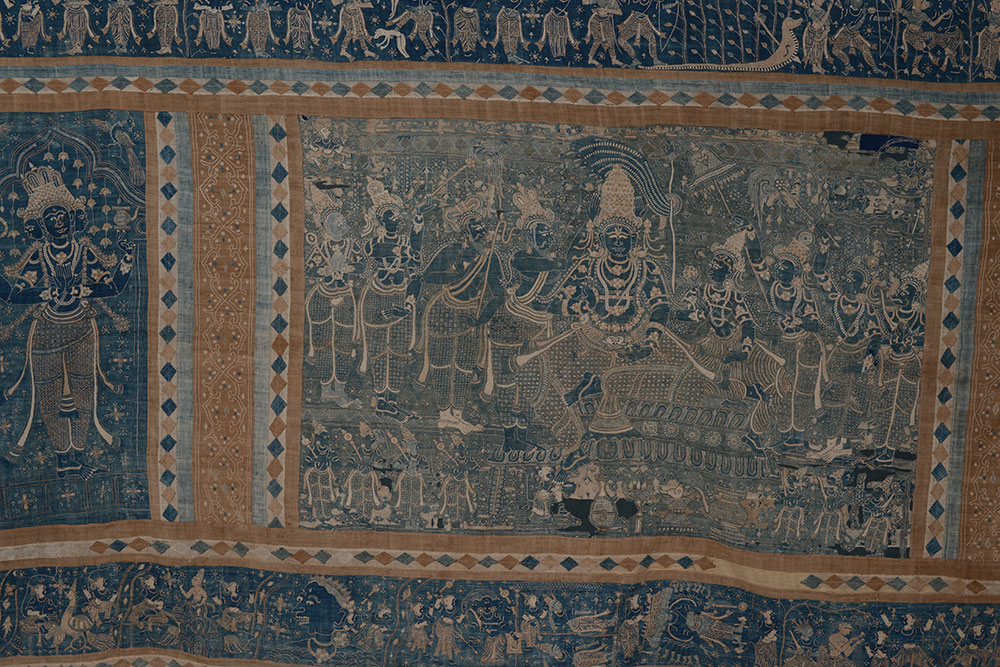As tobacco found favour in the Deccan, local manufacturers turned out thousands of silver or gold inlaid Bidri work hookah bases for the well-heeled smokers, while those with shallower pockets made do by fashioning the bases out of coconut shells. Public hookah shops, the medieval equivalent of today’s hookah bars, became a real draw. An 18th-century painting, titled “Commotion in the Bazaar”, shows a busy hookah stall run by two women and their all-male clientele, a mix of native men, Ethiopians and Turks.

Al Buraq
“Commotion in the Bazaar” and this painting above are part of a small but exquisite exhibition, “Nauras – the many arts of the Deccan”, at the National Museum in New Delhi. The exhibition, curated by Priti Bahadur and Kavita Singh, an art history professor at the Jawaharlal Nehru University, is centred on the cosmopolitan world of the Deccan Sultanates at their height in the 15th and 16th centuries. It brings together rarely seen textiles, books, objects and paintings, mostly drawn from the museum’s own collection, to offer a glimpse into a world of refinement and creativity that rivalled the much-celebrated Mughal court in the North.
The Indian Peninsula’s long coastline, and the Deccan’s rich reserves of diamonds and gold, had drawn peoples, goods and ideas from the earliest times. Through changing political regimes, Deccan textiles, gems and metal ware commanded markets across the world.
At the exhibition, among the examples of the manufactured and traded Deccan goods is a hand-painted 17th century kalamkari ‘rumal’, crowded with figures whose features, style of dress or accompanying objects span the world. A Turk chats to a Chinese man. A woman dressed in jama secured in Deccani style with a loose scarf and a European-style feathered hat offers a sultan a glass of wine. An Armenian, possibly a Silk Route trader, carries a Chinese vase. And a yogi examines a pineapple – a recent import from the new world just like tobacco.

Kalamkari Rumal

Pichchwai for Varsha (Rainy season)
This piece of cloth, an example of the textiles that for centuries were exported from the ports on the Peninsula, offers a portrait of the medieval Deccan. Here wealthy Gujarati Vaishnavite merchants settled and commissioned local craftsmen to make the Pichwai “backdrop” paintings for their temples, men of means had the Bhagwat Purana translated into Persian, a Sultana commissioned an Ethiopian architect to design a Rauza (shrine) in which she and her husband, the Sultan of Bijapur, are buried.
It was a world in which a former African slave like Malik Amber could rise to become general, commander-in-chief, prime minister of Ahmednagar – and a thorn in the side of the Mughals until his death. At the exhibition there is a portrait, identified as Malik Ambar, that shows a man wearing a tall turban and carrying a dhup, the straight Deccani sword.
Despite all these achievements, the Deccan region has been little studied by Indian historians. It is the large North India-based empires, whether Ashokan or Mughal, that have been the main focus of interest among major historians, perhaps because of the dominance of the nationalist framework in historical research. A major consequence of this has been that the subcontinent is viewed from the perspective of these great empires. What the exhibition Nauras does is shift the perspective.
Much is made, for instance, of Akbar’s experiment with religious syncretism at his court. Yet, his contemporary Ibrahim Adil Shah II, the Sultan of Bijapur, whose court poet called him “Jagat Guru Badashah”, lived this syncretism. Ibrahim II composed lyric poetry in Dakhini, in which he calls himself the child of Ganesha. His best known work is Kitab-i-Nauras, a collection of 59 songs and 17 verses.
“Nauras” (from which the exhibition takes its title) is a play on the nine rasas or sentiments of Indian aesthetic theory as well as the Persian nauruz, which suggests new beginnings. The Kitab-i-Nauras opens with praise for the Prophet Mohammed, the goddess Saraswati and the renowned Deccani Sufi mystic Gesu Daraz. In one of the poems, Ibrahim writes:
“Our tongues differ but our feelings are the same, Whether we are Turk or Brahmin, The most fortunate person is the one, On whom Saraswati smiles, Ibrahim says, the world seeks knowledge, Be focused on the Word, on the guru, on meditation.”
This sensibility is what some historians have talked of as an encounter between different cultural and linguistic traditions – Indic and Persian, where “Hindu” and “Turk” did not translate into simple religious identities, but were in fact ethnic and linguistic identities. This is different from the standard perspective that evolved from the colonial period, becoming entrenched after independence, of medieval India as a period of a Hindu-Muslim confrontation.

Embroidered hanging
Music was one of the many performing arts that evolved out of this encounter between different cultural traditions. The “singing sultans” of the Deccan made enormous contributions to the development of music and musicology, both as patrons of the art and artists themselves. Compositions by Mohammed Quli Qutub Shah of Golconda are sung even today, 500 years after they were written. At Ibrahim II’s new city Nauraspura, Id-i-Nauras, a festival of music and storytelling, was celebrated whenever a Friday fell on the ninth day of a month.
Two collections of Ragamala paintings – visual representations of musical ragas – anchor the exhibition’s section on music. The Ragamala painting tradition is most often associated with Mughal and Rajput ateliers. But research now suggests that this style may have in fact originated in the Deccan and travelled northwards, just as tobacco and the hookah did.

Bidriware hookah base decorated with scenes from the Padmavat
Nauras is the kind of exhibition that leaves you questioning the received narrative of the nation, the fixation with simplistic religious identities and the cultural timorousness that regards difference as a threat. It leaves you thinking long after you have exited the show. What stays with you, among other things, is the silver inlay on a pot-shaped bidriwork hookah base, picturising Malik Mohammed Jayasi’s Padmavat. An epic poem, Padmavat tells the tragic story of the love of Raja Ratan Singh of Chittor for Padmavati, princess of Ceylon, who committed jauhar (suicide) during Allaudin Khilji’s siege of Chittor. This was a 16th century story of love – pure love (Ratan Singh’s) and carnal love (Allaudin’s) – not of religious conquest. How then did it turn, in our times, into an example of religious violence and religious honour?

Tuzuk-i-Asafiya, City of Hyderabad
Nauras is expected to become the National Museum’s first online exhibition. This will give the world outside Delhi an opportunity to see the remarkable objects on display and the colourful and complex tale they tell of India’s past.













